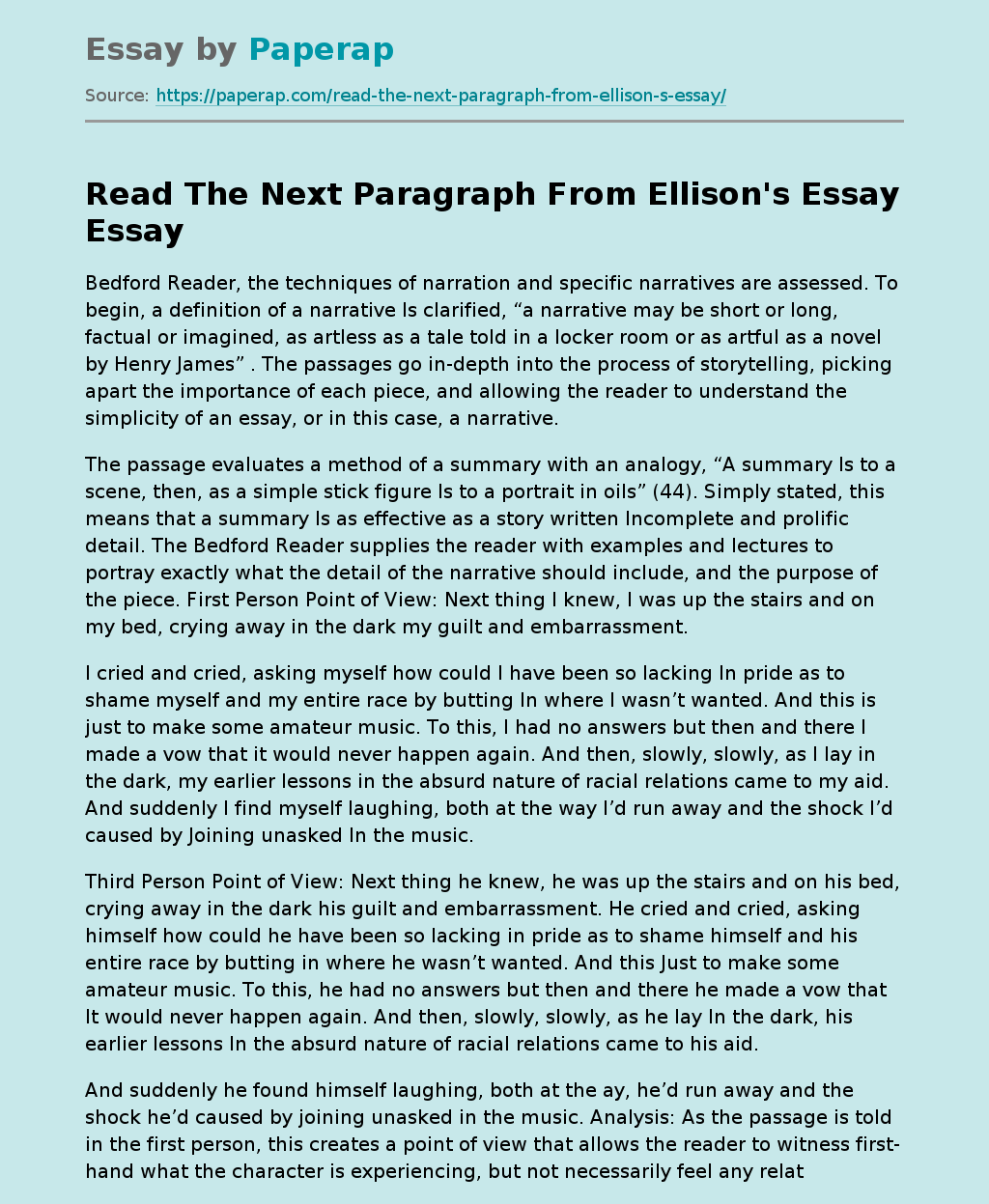Read The Next Paragraph From Ellison's Essay
Bedford Reader, the techniques of narration and specific narratives are assessed. To begin, a definition of a narrative Is clarified, “a narrative may be short or long, factual or imagined, as artless as a tale told in a locker room or as artful as a novel by Henry James” . The passages go in-depth into the process of storytelling, picking apart the importance of each piece, and allowing the reader to understand the simplicity of an essay, or in this case, a narrative.
The passage evaluates a method of a summary with an analogy, “A summary Is to a scene, then, as a simple stick figure Is to a portrait in oils” (44). Simply stated, this means that a summary Is as effective as a story written Incomplete and prolific detail. The Bedford Reader supplies the reader with examples and lectures to portray exactly what the detail of the narrative should include, and the purpose of the piece. First Person Point of View: Next thing I knew, I was up the stairs and on my bed, crying away in the dark my guilt and embarrassment.
I cried and cried, asking myself how could I have been so lacking In pride as to shame myself and my entire race by butting In where I wasn’t wanted. And this is just to make some amateur music. To this, I had no answers but then and there I made a vow that it would never happen again. And then, slowly, slowly, as I lay in the dark, my earlier lessons in the absurd nature of racial relations came to my aid.
And suddenly I find myself laughing, both at the way I’d run away and the shock I’d caused by Joining unasked In the music.
Third Person Point of View: Next thing he knew, he was up the stairs and on his bed, crying away in the dark his guilt and embarrassment. He cried and cried, asking himself how could he have been so lacking in pride as to shame himself and his entire race by butting in where he wasn’t wanted. And this Just to make some amateur music. To this, he had no answers but then and there he made a vow that It would never happen again. And then, slowly, slowly, as he lay In the dark, his earlier lessons In the absurd nature of racial relations came to his aid.
And suddenly he found himself laughing, both at the ay, he’d run away and the shock he’d caused by joining unasked in the music. Analysis: As the passage is told in the first person, this creates a point of view that allows the reader to witness first-hand what the character is experiencing, but not necessarily feel any relation to them. The use of “l” allows the reader to sort of Imagine their own adventure, or base the story on their own Ideas or Interpretations. The third-person point of view for “On Being a Target for Discrimination,” separates the reader from the speaker of the passage.
By using “next thing he knew,” and “he found himself laughing,” the reader develops a sense of what the character is feeling, but not on a personal level. The situation of the scene is almost as someone was looking down from above and witnessing the accounts, but not necessarily emotionally Involved. “On Being a Target for Discrimination,” Ralph Ellison’s subsequent use of ten 2nd-person pilots AT blew made ten passages Doolittle to read as ten repetitions AT “you” and “yours” were overwhelming. As the current literature read today, the 2nd person point of view is not common.
Ellison’s use of “you/your” has a specific purpose, allowing the reader to sympathize with the struggle the character experiences. By allowing yourself to capture the mind of the main character and shadow them as they undergo the struggles of racial discrimination and the personal emotions that are suffered along with it. Using this point of view can be risky, and most authors won’t take the challenge upon themselves, creating a notable piece of work that forces the reader to take part in the actual situation.
The key similarity between the point of view of “Champion of the World,” and “On Being the Target of Discrimination,” is obviously that both authors share the same racial background. Maya Angelo and Ralph Ellison, being African-American, display their similar attitudes and values; however their styles of point of view are what distinctly detach them. In Mama’s point of view of the character, Joe Louis, he finds himself overcoming the racial boundaries through violent means, unlike Rally’s character that is discovering himself through revelation.
Read The Next Paragraph From Ellison's Essay. (2019, Dec 05). Retrieved from https://paperap.com/read-the-next-paragraph-from-ellison-s-essay/

